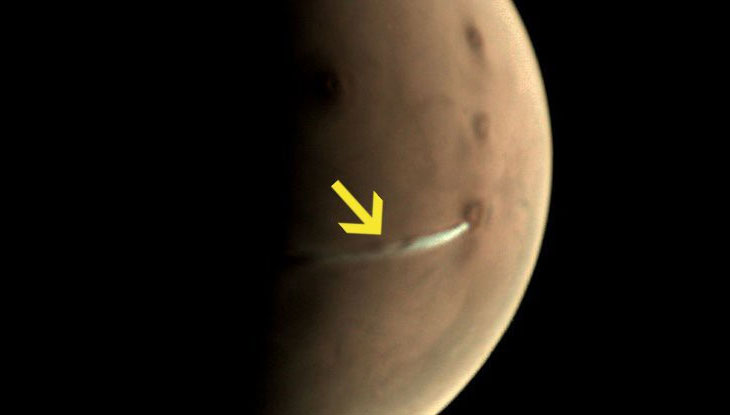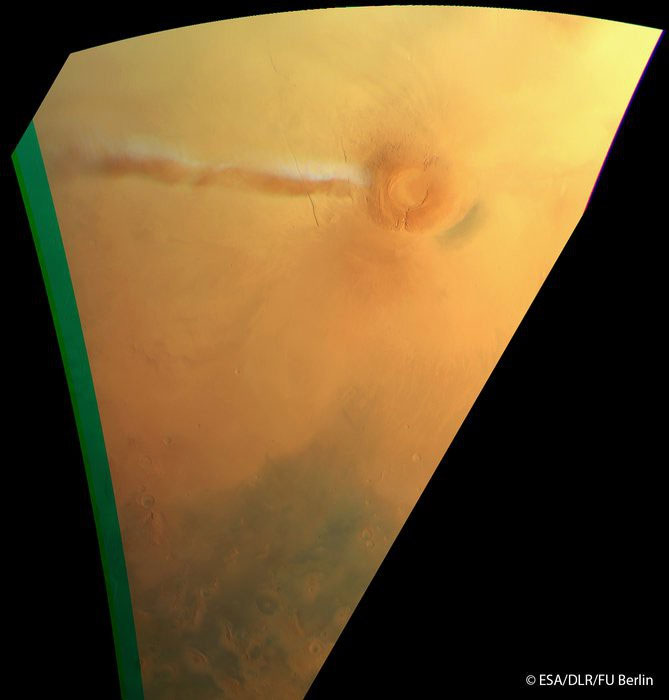The truth is why white smoke is floating on the surface of Mars
Looks like smoke from a volcano, but Mars's volcanic suffering has been cold for a long time. So what is that cloud?
Recent images sent by Mars Express satellite from Mars have shown a very strange phenomenon. In the area near the equator of Red Planet, just above the volcano range is a cloud of white opaque clouds that are floating strangely.
At first glance, it is like a cloud of smoke created by volcanic activities. However, the problem is that the volcano on Mars has cooled long ago. So what is this white smoke?

Photos taken on September 13.
It is known that this image was taken from September 13, in the volcanic region of Arsia Mons . The smoke spread to 1,500km, hovering long enough and moving with the weather so that Earth's satellite could recognize it.
The source of the smoke is still unknown. According to experts of ESA (European Space Agency), although the smoke is very similar to volcanic smoke, unfortunately not. Mars has not had any active volcanoes for millions of years, and the possibility of Arsia Mons suddenly waking up is zero.

Photos recently provided by ESA, taken on September 23.
However, this does not mean that Arsia Mons is not responsible. ESA said, this phenomenon is called meteorological "cloud peak" by meteorologists .
On Earth, this phenomenon often appears on the flank of the mountains, formed by the thick air below the mountain climbing and bulging above, meeting the temperature low enough for moisture to condense, creating into clouds.
On Mars, science has proved, and in the air there is also a fraction of steam. Therefore, the clouds at Arsia Mons are in fact often present most of the time of the year, especially in the months before the winter in the Northern Hemisphere.
However, every few years (from time to time from Earth), Mars meets the criteria for this cloud to become extremely prominent. In fact, Mars Express satellites have "captured" similar images in 2009, 2012 and 2015. With a 3-year cycle, it is not uncommon for this cloud to appear in 2018.
- The mystery of the 'strange smoke' on Mars
- 'White Christmas' on the surface of the red planet
- Turn to the Holy See's smoke-making secret
- Revealing the truth about aliens from 100 years ago
- Mystery of life beneath the surface of Mars
- The truth about 'strange objects' on the surface of Mars
- The surface of Mars is still inactive
- New discovery of life survival under the surface of Mars
- Mars may contain a giant ice lake
- Discovering a 130-meter-thick ice shelf hidden under the surface of Mars
- Mars contains more groundwater than Earth?
- Detecting a 20km lake under the surface of Mars
 Announced 3 houses on the Moon and Mars
Announced 3 houses on the Moon and Mars Science proves: Mars also knows 'deflated'
Science proves: Mars also knows 'deflated' Elon Musk announced the price for a Mars trip was 11.6 billion VND, free of charge
Elon Musk announced the price for a Mars trip was 11.6 billion VND, free of charge NASA discovered strange 'gate' on Mars, is the hiding place found?
NASA discovered strange 'gate' on Mars, is the hiding place found?